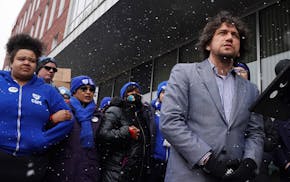Buried in the hubub over what the St. Paul School District plans to do with the two schools it is required to restructure this year is the question of what will happen to teachers at those schools.
Humboldt Junior High School and Arlington Senior High are facing restructuring under the federal No Child Left Behind law, the result of years of test scores that didn't meet the state's benchmarks.
But at a community meeting last month at Humboldt, amid lists of parent concerns about the schools' future, Chief of Schools Nancy Stachel said one thing the district was considering was to "conduct formal observations of all teaching staff to identify areas for improvement and take appropriate action."
The top school-related factor in student performance is teacher quality, education experts say.
The appropriate action regarding teaching, Stachel said, would involve using the same framework the district uses to evaluate new teachers.
The St. Paul district uses a framework it calls "The Standards of Effective Teaching" to evaluate nontenured teachers in the district annually, according to Marilyn Baeker, who oversees elementary the curriculum for St. Paul's Center for Professional Development. Teachers reach tenure after three years of teaching.
Then, principals are no longer required to complete annual evaluations. They can evaluate tenured teachers when they want to, "but they usually don't," Baeker said, unless they have a concern about performance.
If a teacher is falling behind on the job, he or she is placed on an improvement plan and given help and time to improve, "so there isn't an automatic, 'OK, this evaluation is not good, so you're fired.'"
At Arlington and Humboldt, all teachers would be evaluated regardless of whether they are tenured.
The Minneapolis School District -- the only district in the state that has already had to restructure schools -- "fresh started" two high schools this school year. According to Deputy Superintendent Bernadeia Johnson, the district had already put new principals in place at the schools. Those principals were then allowed to select staff for the building by having teachers who wanted to stay reapply for their jobs.
Part of the agreement for those who stayed, Johnson said, was recognizing that "there would be an intonating drive to reconnect with students and families."
"We wanted people who could get really excited about the increased challenges and opportunities that come with being a part of a new school," she said. "It gave the schools an opportunity to coalesce around a common mission and vision and to move forward. ... It's not that you can't do this in other schools, but it gives a school a fresh start."
There is also precedent for that kind of approach in St. Paul. When Dayton's Bluff Elementary was restructured five years ago -- under the then-superintendent's order, rather than a No Child Left Behind mandate -- all teachers in the school had to reapply for their jobs. They could apply to stay -- and agree to increased professional development -- or choose jobs elsewhere in the school system.
Increasing student interest
Arlington High School has recently implemented a new BioSMART program, which gives the school a science, math and technology focus. The program is designed to interest students in the sciences, as well as help create a more rigorous curriculum. District officials hope the moves can, among other things, help satisfy state officials and prevent the school from facing more drastic restructuring.
An oft-mentioned option for Humboldt -- although the district has not made any final decisions -- is to shut down the school for a year to rebuild facilities and programs.
To evaluate and enhance teaching, the St. Paul district uses the "Standards of Effective Teaching" framework, which considers nine elements of effective teaching, including everything from "effective instructional practices" to communication and "managing classroom procedures." Teachers are almost always evaluated by principals or assistant principals.
Teachers usually have a "preconference" with their evaluator, Baeker said, to talk about lesson plans, and a post-conference to let the teacher know the results of the evaluation.
The entire process at Arlington and Humboldt would take "several months," she said, if the district decides to evaluate the entire staff.
"I think it's a very strong tool for looking at instruction," Baeker said. "In terms of an evaluation tool, it's a very fair one."
Emily Johns • 651-298-1541

Lakewood Cemetery in Minneapolis opens new Welcome Center
Man killed in domestic incident in Coon Rapids, Sheriff's Office says

U of M's interim president meets with pro-Palestinian protest leaders

Legendary boys hockey coach Randolph loses his job

